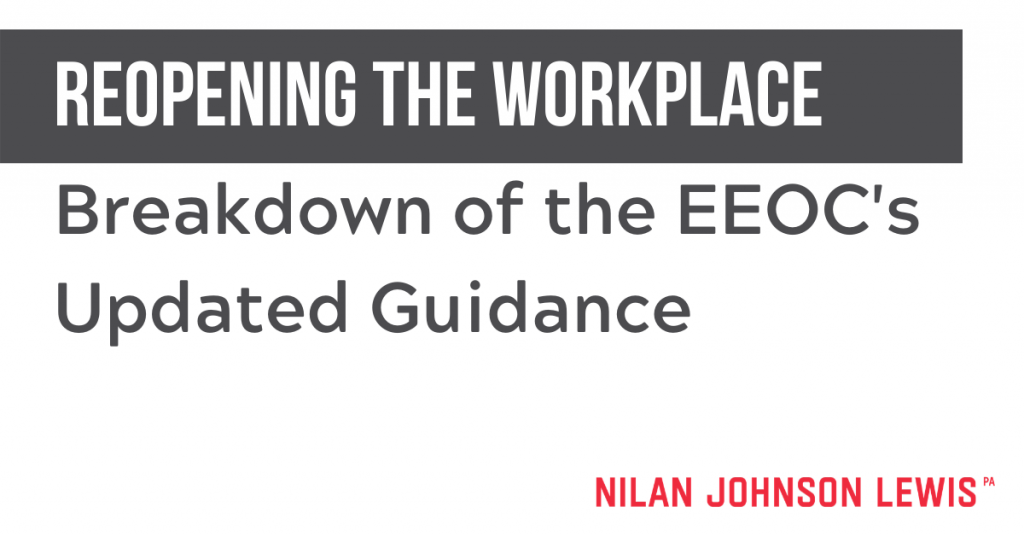
Posted April 23rd, 2020 in Top Stories, Legal Insights with Tags COVID-19, COVID-19 for Employers
Reopening the Workplace: Breaking Down the EEOC’s Updated Guidance
Twice in last week, the EEOC issued additional COVID-19 related guidance designed to aid employers as they begin to welcome employees back to work, including disability accommodation requests under the Americans with Disability Act (ADA) and anti-harassment issues. The EEOC’s expanded guidance is summarized below.
Accommodation Requests and the Interactive Process
The EEOC makes clear that the pandemic does not infringe on an employer’s ability to ask questions or request medical information after an employee requests an accommodation, either at home or in the workplace, for a medical condition that is not obvious or already known. The employer may use the information received to determine whether the employee has a disability as defined under the ADA.
Similarly, an employer may engage in the interactive process the exchange of information—to determine if an employee’s disability necessitates an accommodation. Questions for the employee may include:
- How the disability creates a limitation;
- How the requested accommodation will effectively address the limitation;
- Whether another form of accommodation may effectively address the issue;
- How a proposed accommodation will enable the employee to continue performing the “essential function” of his position
Temporary Accommodations
As government restrictions and public health guidance continue to change as COVID-19 evolves, the need for accommodations may also change and result in more short-term accommodations. As such, employers may forgo or shorten the interactive process to address urgent requests for accommodations where the employer has limited time available to discuss the request. Employers may also assign an end date on the accommodations or provide an accommodation on an interim/trial basis while awaiting medical documentation. This is particularly helpful where the requested accommodation would provide protection to an employee with a pre-existing disability that puts him/her at greater risk during this pandemic, or to employees who have disabilities exacerbated by the pandemic. Notably, employers must consider extending an accommodation if current government restrictions are extended or new ones implemented.
Future Accommodations
Employers may ask employees with disabilities to request accommodations and to engage in the interactive process prior to returning to work.
Undue Hardship
Generally, employers are not required to grant an accommodation that would cause an undue hardship resulting in “significant difficulty” or “significant expense” to the employer. The EEOC recognizes that an undue hardship may look different during the COVID-19 pandemic. An employer must assess each accommodation request based on the facts of the particular job and workplace. Based on EEOC guidance, an employer would have significant difficulty in providing an accommodation during the COVID-19 pandemic if it requires the employer to conduct a needs assessment or acquire certain items where delivery is an issue, particularly for employees working from home. During this time, it may also be significantly more difficult to provide employees with temporary assignments, to remove marginal functions, or to hire temporary workers for specialized positions.
Additionally, the EEOC acknowledges that certain accommodations would pose a significant expense for employers who have experienced a sudden loss in some or all income due to COVID-19. Employers must weigh the costs of an accommodation against their current budget in light of the constraints caused by COVID-19 and determine whether there are any “no-cost” or “low-cost” accommodations available. In these instances, employers may consider the amount of discretionary funds available at this time, and whether there is an expected date that current restrictions on an employer’s operations will be lifted.
In any event, employers and employees should work together to find alternative accommodations that do not pose these issues.
Returning to Work and Issues Posing a Direct Threat
As government stay-at-home orders and other local orders are lifted, employers will begin to reopen their workplace. During this time, the EEOC indicates that employers may continue screening employees to determine whether they present a direct threat. Such screening includes taking temperatures and asking questions about symptoms related to COVID-19 for all individuals entering the workplace. Additionally, the EEOC now takes the position that employers are permitted to administer COVID-19 tests before employees enter the workplace to determine if employees are actively infected with the virus. Employers choosing to administer diagnostic tests are to rely on guidance from medical and public health authorities to choose accurate and reliable tests, taking into account the potential for false-positives and false-negatives. Employers should look to guidance from the CDC and other public health authorities to determine what constitutes a direct threat to their respective workplaces. Similarly, employers should stay informed on CDC’s guidance regarding critical infrastructure workers permitted to continue to work following potential exposure to COVID-19.
Modified Personnel Protective Gear and Infection Control Practices
Employers that require employees to wear personnel protective gear (e.g., non-latex gloves, modified face masks, gowns designed for individuals who use wheelchairs, or other modified equipment due to religious garb) or perform infection control practices should be mindful of accommodation requests for returning workers under the ADA and other Title VII laws. Employers should grant such accommodations or provide alternatives (if feasible) that are not an undue hardship on the employer’s business operations under the ADA or Title VII.
Pandemic-related Harassment and Discrimination
As employers reopen the workplace, the EEOC encourages employers to remind all employees of federal anti-harassment and non-discrimination laws and to consider advising supervisors and managers of their roles in watching for, stopping, and reporting any harassment or other discrimination. Employers may also make clear that it will evaluate all allegations of harassment and discrimination and take appropriate action.